Road to Russia
Published on 07 February 2018
What products do Latin American countries export to the FIFA World Cup, Russia 2018?
The Latin American countries classified to the world soccer championship not only point to Russia to score goals inside the courts. The largest national territory in the world also represents a large market to diversify export products, with a GDP per capita that jumped from US $ 8,946 to US $ 10,248 between 2016 and 2017, and a population of more than 144 million inhabitants.
What is sent from each of these points to the vodka country? In general, Russian demand for Latin American countries is focused on agricultural products (fruits, grains, dairy and meat), fishing and metalworking, to which is added some more complex manufactures such as auto parts, technological products and vehicles. Let's review each country.
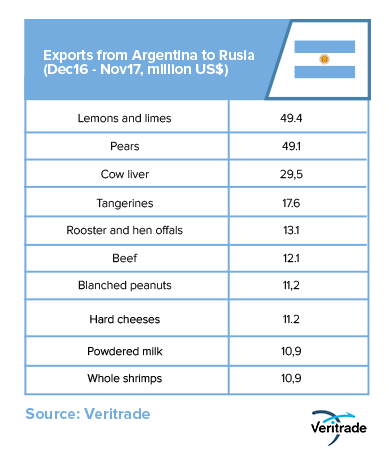
The export offer from Argentina to Russia focuses on products from the countryside. With one of the main livestock industries in the world, it is not surprising that the bulk of the offer is made up of meat and dairy products. Some fruits, vegetables and grains are added, as well as wines and manufactures, in which the generators stand out. The importation of horse meat is surprising, appreciated by the Russian consumer and recurrent in exports from other livestock countries such as Uruguay and Brazil.
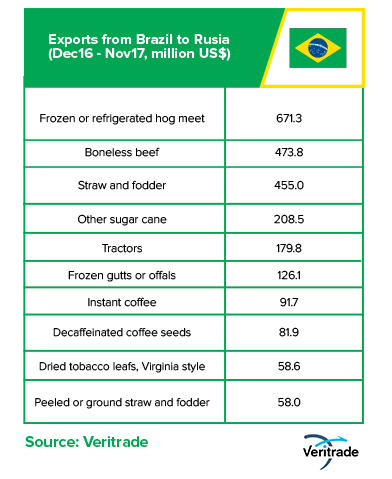
Regarding Brazil, the preponderance of products from the livestock industry is repeated, with a greater participation of pork and sheep meat. It also highlights the distinction of beef cattle to include the zebu, which of course, give rise to an important footwear industry. But if anything distinguishes the exportable supply of Brazil over the entire region, it is its sophistication in heavy manufacturing: none of the other countries exports helicopters and airplanes, and heavy machinery also has a greater preponderance with respect to Mexico, where it is also they assemble vehicles and produce auto parts.
On the other hand, it is worth noting the presence of extensive agricultural crops, such as sugarcane and oilseeds. In the case of coffee, it is important to note that a large part of the shipments are made in processed presentations (mainly instant).
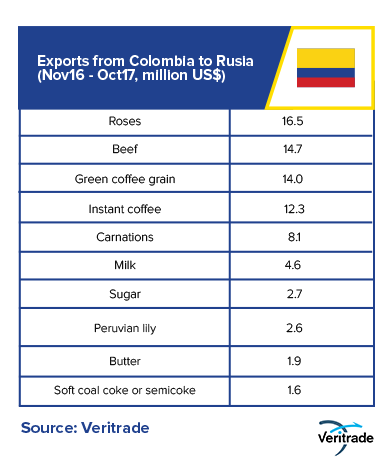
From Colombia, the geography leads to coincidences with Brazil in terms of cattle and coffee, although with a greater preponderance of the Arabica variety. The great distinctive feature of the land of Vallenato is the variety of flowers, produced naturally and in greenhouses. On the other hand, the supply of minerals highlights the importance of coke or coal, an input for the generation of energy and composite materials, which despite having lost value in recent years, is still relevant for its exports. Metal-mechanic manufacturing also has an important place in Colombian industry, and is present in exports to Russia.
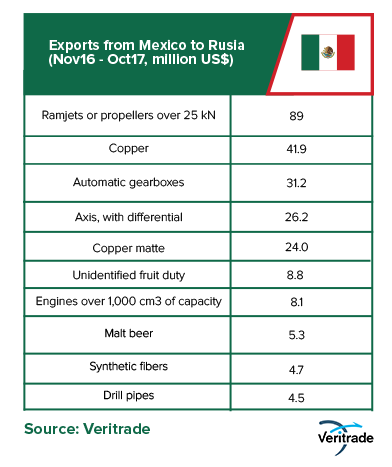
As for Mexico, the exportable supply is balanced between metal-mechanic and technological manufactures, minerals and agricultural products. Like Peru, it is a mining country by nature, so copper has a special relevance, but differs in the advanced of its assembly industry, both auto parts and engines, and audiovisual equipment. Coffee is also important, and in the livestock industry, highlights the export of horse meat, a product consumed by the Russians.
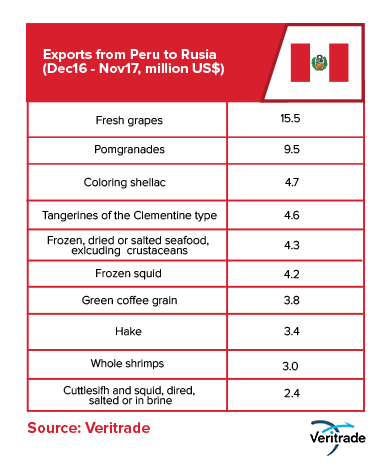
The Peruvian offer focuses on fruits, vegetables, fish, seafood and coffee. But in the middle of the agricultural portfolio, Russia stands out as an important destination for dyes such as cochineal carmine, achiote, paprika and marigold. The only elements of non-agricultural or fishing origin are zinc oxide, parts of machinery and andalusite, a mineral with high heat resistance used as a refractory for the steel industry, the manufacture of spark plugs and earthenware.
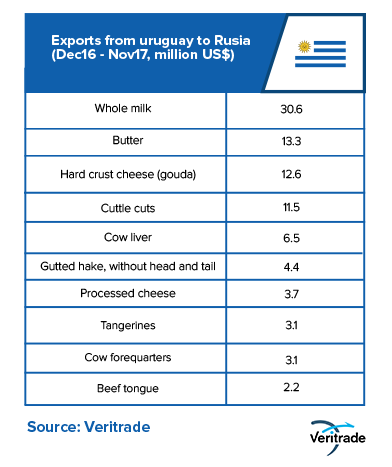
In the Uruguayan case, the predominance of livestock and the dairy industry is absolute. The exception comes from the side of citrus fruits and wines.
Finally, from Central America, shipments from Panama have been only rum, for a value of US $ 1.3 million in the period December 2016 - November 2017. Without a doubt, the Russian market is a good place for the export of liquors, as also shown by the shipments of Argentine wine and Mexican tequila. However, it could also receive other products from Central America, such as sugarcane (as Colombia does), coffee and cacao.
The country that will be the center of global attention for a month between June and July of this year should also be for the rest of the time for these and other countries. The demand for tropical fruits gives space to look for price windows, and the use of metal-mechanic and assembled products opens up an important space for the segments of high added value. The ball is in the court of the exporters.
Enter https://bit.ly/2BMbhj1 and request yout frial trial.